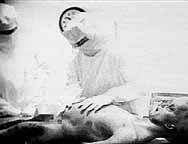
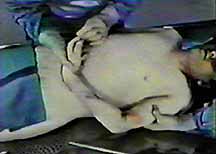
Left: The examiners handle the alien as if it were a live hand grenade.
Right: In the Army How-To video, the examiners flip the body
around like Julia Child preparing to filet a trout.
Actually we agree. If this film is any guide, then alien corpses and human corpses are indeed very different. However, alien corpses and special FX dummies are strikingly similar!
Our answer to the "aliens are different" argument is: the "alien" has humanoid musculature, and apparently a humanoid bone structure. And for a terrestrial-style skeleton and muscle system to work, semi-elastic skin is required. Otherwise, the creature can't move. (Unless you think the alien has a jointed exoskeleton?)
Anyway, we think that no matter where the thing came from, if it's a real humanoid, it oughta look like a humanoid when it gets autopsied. Which it doesn't.
Or maybe you're one of the folks who wonders if the film used a real human corpse as a stand-in for an alien - maybe you'll want to consider this page from that perspective instead.


Left: The examiners handle the alien as if it were a live hand grenade.
Right: In the Army How-To video, the examiners flip the body
around like Julia Child preparing to filet a trout.
(The picture above right is just the beginning of the Army video's "external exam" demonstration - we've spared you the rest, especially the charming genital/anal examination sequence. You're welcome.)
Unfortunately, still pictures don't properly convey two very obvious differences between the two "exams":
But the "doctors" in the alien video manage to do an entire autopsy without once moving the body. Have military autopsy techniques changed that much between 1947 and 1961, when the "How-To" film was made by the Army?
Or...maybe they don't move the alien because it's a dummy without real bones, muscles and skin - and it'll look terrible if they move it?
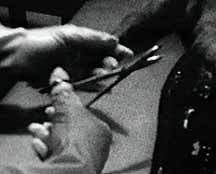

Left: The "alien autopsy" way - thumb and index finger.
Right: The pathologist's way - thumb and middle finger.
This is not a matter of personal choice - the method at left is just plain wrong. Ask any surgeon.
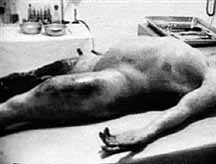

All of which makes sense if the alien corpse is the result of a body-cast on a standing, living subject.

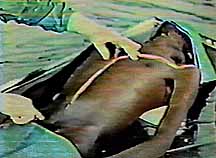
Left (alien) - skin doesn't retract spontaneously when cut. Bleeding is dramatic but unrealistic.
Right (human) - skin retracts spontaneously when cut. Lack of bleeding is realistic but undramatic.
A good example of skin elasticity, and the alien's lack thereof.
The Army video also demonstrates the standard incision technique - a single, aggressive cut, rather than three tentative cuts as seen in the "alien" video.
Note also the use of a "body block" under the corpse at right. The body block has been standard pathologist's equipment since Michaelangelo's day - its purpose is to elevate the chest for easier examination.
(Unless you're autopsying an alien, of course, in which case [insert rationalization here].)
Our rationalization? A dummy wouldn't flex properly around a body block unless the original human subject was body-cast in the same position - something the hoaxers apparently didn't think of doing. Too bad - it would have made the end result much more convincing! Or - perhaps their autopsy homework was incomplete and they simply didn't know about body blocks (or how to properly hold the scissors...)
The Truly Dangerous Company
 Return To UFO Information Menu.
Return To UFO Information Menu.